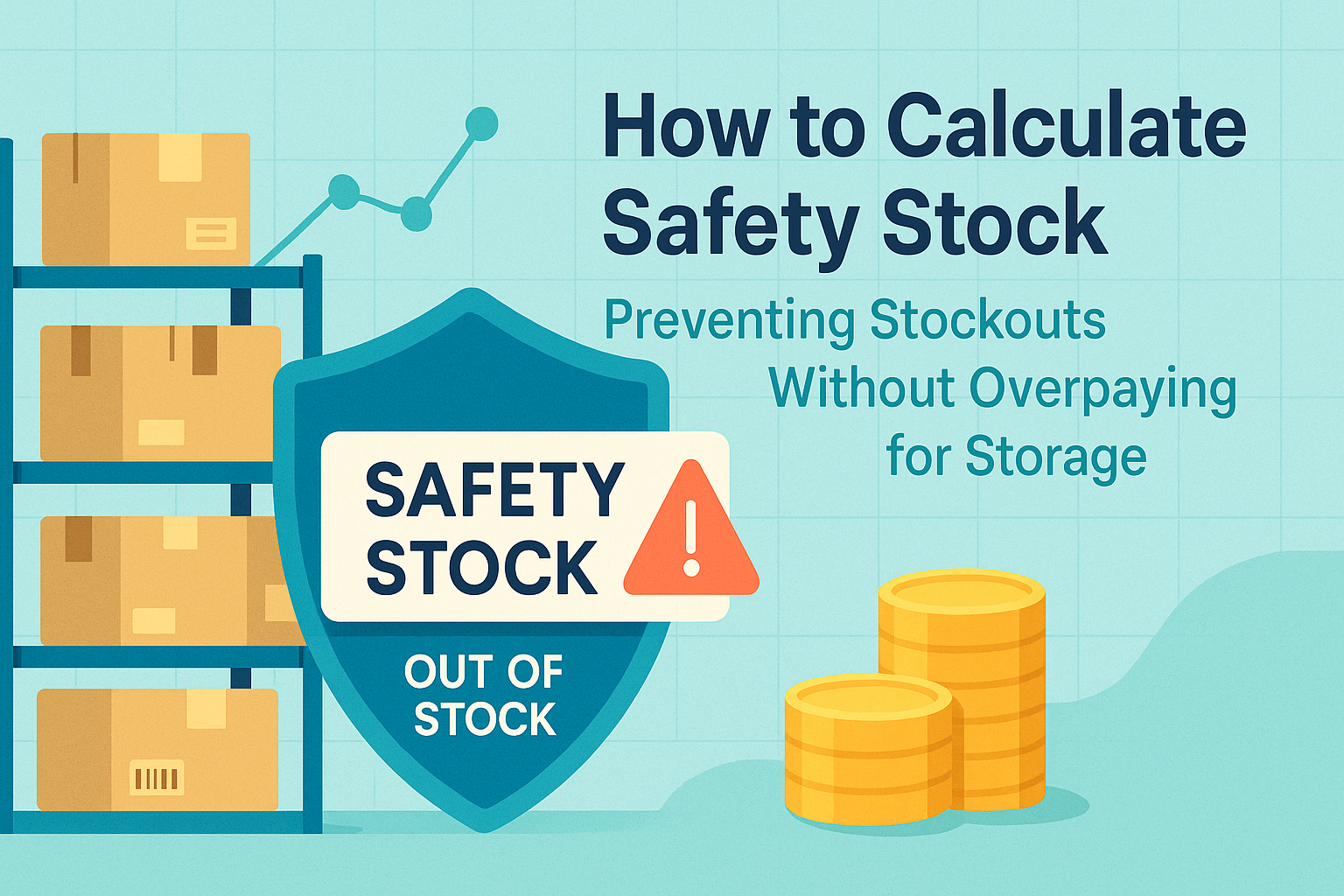This isn’t just about having “a little extra” on hand. It’s a strategic calculation that acts as your business’s insurance policy against the unpredictable. From unexpected spikes in demand to unforeseen supply chain disruptions, a well-calibrated safety stock protects your business’s momentum. But how do you determine the magic number without overpaying for storage or under-preparing for the market?
What is Safety Stock? More Than Just a “Buffer”
Safety stock, also known as buffer stock, is the extra quantity of a product held in inventory to mitigate the risk of a stockout. It’s the essential reserve you keep to handle fluctuations in demand and lead time variability. Without it, even a minor delay from your supplier or a sudden surge in customer orders could bring your operations to a halt.
Think of it this way: your regular inventory is like the fuel in your car’s tank for a planned trip. Safety stock is the spare can you keep in the trunk—you hope you never need it, but you’re grateful it’s there if you do.
The Key Variables in Your Safety Stock Formula
Calculating safety stock isn’t a one-size-fits-all process. The most effective methods consider several critical variables, each with its own level of uncertainty. Understanding these is the first step toward a robust inventory strategy.
- Maximum Daily Usage: The highest number of units you have sold or used in a single day. This accounts for peak demand scenarios.
- Average Daily Usage: Your typical, day-to-day sales or usage rate. This is the baseline for your inventory needs.
- Maximum Lead Time: The longest it has ever taken for a supplier to deliver an order after you’ve placed it. This accounts for unexpected delays.
- Average Lead Time: The typical time it takes for an order to arrive.
The core challenge is balancing these variables. Overestimating can lead to bloated inventory and higher warehouse storage costs. Underestimating can leave you vulnerable to stockouts.
Comparing the Top 3 Safety Stock Calculation Methods
While there are many approaches, three methods stand out for their practicality and effectiveness. We’ll break down each with formulas and real-world case studies.
1. The Basic Safety Stock Formula: A Simple Starting Point
This is the most straightforward method, ideal for businesses just starting to formalize their inventory management.
Formula:
Safety Stock = (Maximum Daily Usage × Maximum Lead Time) - (Average Daily Usage × Average Lead Time)Case Study: “Peak Season Preparedness”
A small e-commerce brand selling custom t-shirts experiences a seasonal demand spike before summer. They want to calculate their safety stock for their most popular design.
- Maximum Daily Usage: 150 units (during a flash sale)
- Average Daily Usage: 50 units
- Maximum Lead Time: 20 days (due to a holiday delay from the supplier)
- Average Lead Time: 10 days
Safety Stock = (150 units × 20 days) - (50 units × 10 days)Safety Stock = 3000 - 500 = 2500 unitsAnalysis: This method is intuitive and easy to implement. However, it relies heavily on historical maximums, which may not always be a reliable predictor of future demand, especially for highly volatile products.
2. The Standard Deviation Formula: For More Predictable Demand
This method, often used in more mature inventory systems, factors in the variability of both demand and lead time. It’s more statistically sound and offers a more nuanced calculation.
Formula:
Safety Stock = Z × √((Average Lead Time × σD²) + (Average Daily Demand² × σLT²))- Z (Service Factor): A value from a Z-table that corresponds to your desired service level. A higher service level (e.g., 99%) means a lower risk of stockouts.
- σD (Standard Deviation of Daily Demand): Measures how much your daily demand varies from the average.
- σLT (Standard Deviation of Lead Time): Measures how much your supplier’s lead time varies from the average.
Case Study: “The High-Value Electronics”
A company selling high-end headphones has stable but slightly unpredictable demand. They aim for a 95% service level to avoid stockouts on these expensive items.
- Average Daily Demand: 20 units
- Standard Deviation of Daily Demand: 5 units
- Average Lead Time: 14 days
- Standard Deviation of Lead Time: 3 days
- Z-score for 95% Service Level: 1.65
Safety Stock = 1.65 × √((14 × 5²) + (20² × 3²))Safety Stock = 1.65 × √((14 × 25) + (400 × 9))Safety Stock = 1.65 × √(350 + 3600)Safety Stock = 1.65 × √(3950)Safety Stock ≈ 1.65 × 62.85 ≈ 104 unitsAnalysis: This method is highly accurate but requires more data and statistical knowledge. It’s perfect for businesses with predictable demand and reliable data tracking.
3. The Fixed Safety Stock Method: Simplicity for Strategic SKUs
This is less of a calculation and more of a policy. A fixed number of units is designated as safety stock for a specific SKU, often determined by management based on historical data or product importance.
Case Study: “Critical Spare Parts”
An industrial equipment supplier designates a fixed safety stock of 50 units for a critical replacement part. This part is essential for their B2B clients’ operations, and a stockout would be catastrophic, regardless of cost.
Analysis: While simple and effective for high-priority or low-volume items, this method lacks dynamic adaptability. It doesn’t adjust to changes in demand or lead time, which can lead to overstocking or under-stocking over time.
Comparative Analysis: Which Method Is Right for You?
Choosing the right method depends on your business’s size, product type, and data availability. Here’s a quick-reference table to help you decide.
| Method | Best For | Pros | Cons |
|---|---|---|---|
| Basic Formula | Small businesses, volatile demand, limited data. | Simple, easy to understand and implement. | Less accurate, can lead to overstocking. |
| Standard Deviation | Mature businesses, predictable demand, robust data. | Highly accurate, balances risk and cost. | Requires more data, complex calculation. |
| Fixed Safety Stock | Critical SKUs, low-volume high-value items. | Simple, ensures availability of key products. | Not dynamic, can be inefficient for most inventory. |
How a 3PL Partner Elevates Your Safety Stock Strategy
Even with the perfect formula, managing safety stock across a growing e-commerce business is complex. This is where a third-party logistics (3PL) partner, like WarehouseTX, becomes invaluable. A great 3PL can provide:
- Real-Time Data: Gain instant visibility into your inventory levels, sales velocity, and returns. This data is crucial for accurate safety stock calculations.
- Distributed Inventory: Our nationwide network of fulfillment centers in strategic locations like Texas and New Jersey allows you to hold safety stock closer to your customers, reducing lead times and mitigating shipping delays.
- Technology & Automation: Modern 3PLs use advanced warehouse management systems (WMS) that can automate reorder points and even suggest safety stock levels based on real-time data analysis.
Your Next Steps: A Practical Action Plan
Ready to master your safety stock and take control of your inventory? Follow these steps:
- Analyze Your Data: Start by gathering historical data on daily demand and supplier lead times for your top-selling products.
- Choose Your Method: Based on the analysis, select the safety stock calculation method that best suits your business model.
- Implement & Monitor: Integrate your calculated safety stock levels into your inventory management system. Regularly review and adjust these levels as your business grows and market conditions change.
By taking a data-driven approach, you move from guessing to knowing, transforming your inventory from a liability into a strategic asset. If you’re looking for a partner to help you navigate this journey, explore our warehouse and storage solutions designed for e-commerce growth.
FAQ
What is the difference between safety stock and reorder point?
Safety stock is the extra inventory you hold to prevent stockouts. The reorder point, on the other hand, is the specific inventory level that triggers a new order from your supplier. The reorder point is calculated by adding your safety stock to the demand you expect to fulfill during the lead time. For example, if your average daily demand is 10 units, your average lead time is 5 days, and your safety stock is 20 units, your reorder point would be (10 units/day * 5 days) + 20 units = 70 units.
How often should I recalculate my safety stock?
This depends on your business. For businesses with stable demand, a quarterly or bi-annual review might be sufficient. However, for companies experiencing rapid growth, seasonal fluctuations, or frequent supply chain issues, a monthly or even weekly review is highly recommended. The goal is to ensure your safety stock levels accurately reflect current market conditions and supplier performance.
What is a good service level to aim for?
The “best” service level varies by industry and product. A higher service level (e.g., 95% or 99%) is crucial for high-value or critical items where a stockout is very costly. For lower-cost, high-volume items, a slightly lower service level (e.g., 90%) might be acceptable, as the cost of holding excessive safety stock could outweigh the potential lost revenue from a stockout.
Can I use the same safety stock calculation for all my products?
No, a one-size-fits-all approach is not recommended. Products with high demand volatility and unreliable suppliers require a higher safety stock. Conversely, products with stable demand and a consistent supply chain can operate with a lower safety stock level. A product-by-product analysis, often categorized by ABC inventory analysis (A-items being most critical), is the most effective approach.

